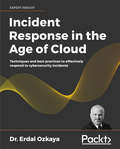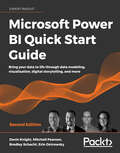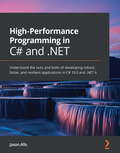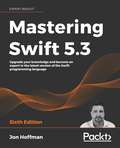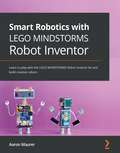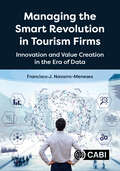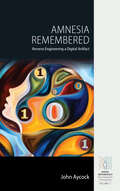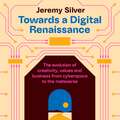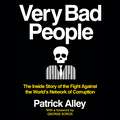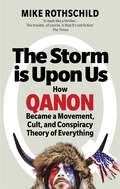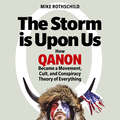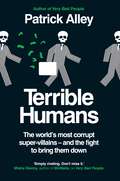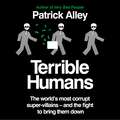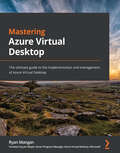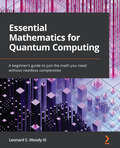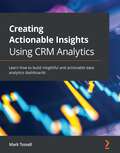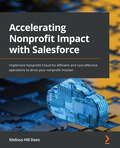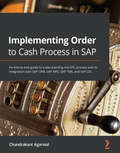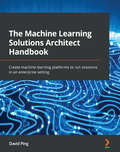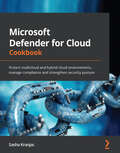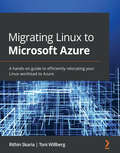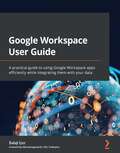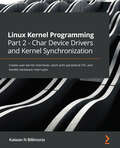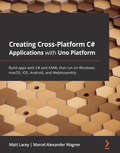- Table View
- List View
Incident Response in the Age of Cloud: Techniques and best practices to effectively respond to cybersecurity incidents
by Dr. Erdal OzkayaLearn to identify a security incident and build a series of best practices to stop a cyberattack before it creates serious consequencesKey FeaturesDiscover Incident Response (IR), from its evolution to implementationUnderstand cybersecurity essentials and IR best practices through real-world phishing incident scenariosExplore the current challenges in IR through the perspectives of leading figures in the cybersecurity communityBook DescriptionCybercriminals are always in search of new methods and ways to infiltrate systems. Quickly responding to an incident should help an organization minimize its losses, decrease vulnerabilities, and rebuild services and processes. In the wake of the COVID-19 pandemic, with most organizations gravitating towards remote working and cloud computing, this book provides updated IR processes to address the associated security risks. The book begins by introducing you to the cybersecurity landscape and explaining why IR matters. You will understand the evolution of IR, current challenges, key metrics, and the composition of an IR team, along with an array of methods and tools used in an effective IR process. You will then learn how to apply this conceptual toolkit, with discussions on incident alerting, handling, investigation, recovery, and reporting. Further, you will cover governing IR on multiple platforms and sharing cyber threat intelligence, and the procedures involved in IR in the cloud – the challenges, opportunities, and how to secure your cloud environments. Finally, the book concludes with an “Ask the Experts” section where industry experts have provided their perspective on diverse topics in the IR sphere. By the end of this book, you should become proficient at building and applying IR strategies pre-emptively and confidently. What you will learnUnderstand IR and its significanceOrganize an IR teamExplore best practices for managing attack situations with your IR teamForm, organize, and operate a product security team to deal with product vulnerabilities and assess their severityOrganize all the entities involved in product security responseRespond to a security vulnerability based on Keepnet Labs processes and practicesAdapt all the above learnings for the cloudWho this book is forThis book is aimed at first-time incident responders, cybersecurity enthusiasts who want to get into IR, and anyone who is responsible for maintaining business security. It will also interest CIOs, CISOs, and members of IR, SOC, and CSIRT teams. However, IR is not just about information technology (IT) or security teams, and anyone with a legal, HR, media, or other active business role would benefit from this book.The book assumes you have some admin experience. No prior DFIR experience is required. Some infosec knowledge will be a plus but isn't mandatory.
Microsoft Power BI Quick Start Guide: Bring your data to life through data modeling, visualization, digital storytelling, and more, 2nd Edition
by Devin Knight Mitchell Pearson Bradley Schacht Erin OstrowskyAn accessible fast paced introduction to all aspects of Power BI for new or aspiring BI professionals, data analysts, and data visualizersKey FeaturesUpdated with the latest features in Power BI including Dataflow, AI insights, visuals and row level securityGet faster and more intuitive data insights using Microsoft Power BI and its business intelligence capabilitiesBuild accurate analytical models, reports, and dashboardsBook DescriptionThis revised edition has been fully updated to reflect the latest enhancements to Power BI. It includes a new chapter dedicated to dataflow, and covers all the essential concepts such as installation, designing effective data models, as well as building basic dashboards and visualizations to help you and your organization make better business decisions.You'll learn how to obtain data from a variety of sources and clean it using Power BI Query Editor. You'll then find out how you can design your data model to navigate and explore relationships within it and build DAX formulas to make your data easier to work with. Visualizing your data is a key element in this book, and you'll get to grips rapidly with data visualization styles and enhanced digital storytelling techniques.In addition, you will acquire the skills to build your own dataflows, understand the Common Data Model, and automate data flow refreshes to eradicate data cleansing inefficiency.This guide will help you understand how to administer your organization's Power BI environment so that deployment can be made seamless, data refreshes can run properly, and security can be fully implemented.By the end of this Power BI book, you'll have a better understanding of how to get the most out of Power BI to perform effective business intelligence.What you will learnConnect to data sources using import and DirectQuery optionsUse Query Editor for data transformation and data cleansing processes, including writing M and R scripts and dataflows to do the same in the cloudDesign optimized data models by designing relationships and DAX calculationsDesign effective reports with built-in and custom visualsAdopt Power BI Desktop and Service to implement row-level securityAdminister a Power BI cloud tenant for your organizationUse built-in AI capabilities to enhance Power BI data transformation techniquesDeploy your Power BI desktop files into the Power BI Report ServerWho this book is forAspiring business intelligence professionals who want to learn Power BI will find this book useful. If you have a basic understanding of BI concepts and want to learn how to apply them using Microsoft Power BI, this book is for you.
High-Performance Programming in C# and .NET: Understand the nuts and bolts of developing robust, faster, and resilient applications in C# 10.0 and .NET 6
by Jason AllsEnhance your applications' performance using best practices for benchmarking, application profiling, asynchronous programming, designing responsive UIs, gRPC communication, and distributed applicationsKey FeaturesMake the best use of performance enhancements in C# 10.0 and .NET 6Boost application performance by identifying hardware bottlenecks and common performance pitfallsGet to grips with best practices and techniques for improving the scalability of distributed systemsBook DescriptionWriting high-performance code while building an application is crucial, and over the years, Microsoft has focused on delivering various performance-related improvements within the .NET ecosystem. This book will help you understand the aspects involved in designing responsive, resilient, and high-performance applications with the new version of C# and .NET.You will start by understanding the foundation of high-performance code and the latest performance-related improvements in C# 10.0 and .NET 6. Next, you'll learn how to use tracing and diagnostics to track down performance issues and the cause of memory leaks. The chapters that follow then show you how to enhance the performance of your networked applications and various ways to improve directory tasks, file tasks, and more. Later, you'll go on to improve data querying performance and write responsive user interfaces. You'll also discover how you can use cloud providers such as Microsoft Azure to build scalable distributed solutions. Finally, you'll explore various ways to process code synchronously, asynchronously, and in parallel to reduce the time it takes to process a series of tasks.By the end of this C# programming book, you'll have the confidence you need to build highly resilient, high-performance applications that meet your customer's demands.What you will learnUse correct types and collections to enhance application performanceProfile, benchmark, and identify performance issues with the codebaseExplore how to best perform queries on LINQ to improve an application's performanceEffectively utilize a number of CPUs and cores through asynchronous programmingBuild responsive user interfaces with WinForms, WPF, MAUI, and WinUIBenchmark ADO.NET, Entity Framework Core, and Dapper for data accessImplement CQRS and event sourcing and build and deploy microservicesWho this book is forThis book is for software engineers, professional software developers, performance engineers, and application profilers looking to improve the speed of their code or take their skills to the next level to gain a competitive advantage. You should be a proficient C# programmer who can already put the language to good use and is also comfortable using Microsoft Visual Studio 2022.
Mastering Swift 5.3: Upgrade your knowledge and become an expert in the latest version of the Swift programming language, 6th Edition
by Jon HoffmanA comprehensive guide for programming enthusiasts who wish to gain a firm command of the fundamentals and advanced Swift conceptsKey FeaturesSixth edition of this bestselling book, improved and updated to cover the latest version of the Swift 5.3 programming languageGet to grips with popular and modern design techniques to write easy-to-manage Swift codeUse core Swift features such as concurrency, generics, and copy-on-write in your codeBook DescriptionOver the years, Mastering Swift has proven itself among developers as a popular choice for an in-depth and practical guide to the Swift programming language. This sixth edition comes with the latest features, an overall revision to align with Swift 5.3, and two new chapters on building swift from source and advanced operators.From the basics of the language to popular features such as concurrency, generics, and memory management, this in-depth guide will help you develop your expertise and mastery of the language.As you progress, you will gain practical insights into some of the most sophisticated elements in Swift development, including protocol extensions, error handling, and closures. The book will also show you how to use and apply them in your own projects. In later chapters, you will understand how to use the power of protocol-oriented programming to write flexible and easier-to-manage code in Swift. Finally, you will learn how to add the copy-on-write feature to your custom value types, along with understanding how to avoid memory management issues caused by strong reference cycles.By the end of this Swift book, you will have mastered the Swift 5.3 language and developed the skills you need to effectively use its features to build robust applications.What you will learnUnderstand core Swift components, such as operators, collections, control flows, and functionsIdentify how and when to use classes, structures, and enumerationsUse protocol-oriented design with extensions to write easy-to-manage codeLeverage design patterns with Swift to solve commonly occurring design problemsApply copy-on-write for your custom value types to improve performanceAdd concurrency to your applications using Grand Central Dispatch and operation queuesImplement generics to write flexible and reusable codeWho this book is forThis book is for beginners with a basic understanding of programming and experienced developers looking to learn Swift programming. Familiarity with Apple's tools will be beneficial but not mandatory. All examples should also work on the Linux and Windows platforms
Smart Robotics with LEGO MINDSTORMS Robot Inventor: Learn to play with the LEGO MINDSTORMS Robot Inventor kit and build creative robots
by Aaron MaurerDiscover how to use the LEGO MINDSTORMS Inventor kit and boost your confidence in roboticsKey FeaturesGain confidence in building robots using creative designsLearn advanced robotic features and find out how to integrate them to build a robotWork with the block coding language used in robotics software in a practical wayBook DescriptionLEGO MINDSTORMS Robot Inventor is the latest addition to the LEGO MINDSTORMS theme. It features unique designs that you can use to build robots, and also enable you to perform activities using the robot inventor application. You'll begin by exploring the history of LEGO MINDSTORMS, and then delve into various elements of the Inventor kit. Moving on, you'll start working on different projects which will prepare you to build a variety of smart robots. The first robotic project involves designing a claw to grab objects, and helps you to explore how a smart robot is used in everyday life and in industry. The second project revolves around building a working guitar that can be played and modified to meet the needs of the user. As you advance, you'll explore the concept of biomimicry as you discover how to build a scorpion robot. In addition to this, you'll also work on a classic robotic challenge by building a sumobot. Throughout the book, you'll come across a variety of projects that will provide you with hands-on experience in building creative robots, such as building a Dragster, Egg Decorator, and Plankton from Spongebob Squarepants. By the end of this LEGO book, you'll have got to grips with the concepts behind building a robot, and also found creative ways to integrate them using the application based on your creative insights and ideas.What you will learnDiscover how the Robot Inventor kit works, and explore its parts and the elements inside themDelve into the block coding language used to build robotsFind out how to create interactive robots with the help of sensorsUnderstand the importance of real-world robots in today's landscapeRecognize different ways to build new ideas based on existing solutionsDesign basic to advanced level robots using the Robot Inventor kitWho this book is forThis book is for robot enthusiasts, LEGO lovers, hobbyists, educators, students, and anyone looking to learn about the new LEGO Robot Inventor kit. This book is designed to go beyond the basic build through to intermediate and advanced builds, and enables you to add your personal flair to the builds and codes.
Managing the Smart Revolution in Tourism Firms: Innovation and Value Creation in the Era of Data
by Dr Francisco Navarro-MenesesSmart Technologies are revolutionizing tourism, as they promise to change the way tourists behave and how companies interact with them and generate profits. The increasing availability of real-time data in combination with advanced machine learning techniques, artificial intelligence and business analytics, to name but a few, will transform the tourism industry forever and in unthinkable ways. The degree of sophistication achieved by Smart Technologies and the speed with which transformations are taking place means that those people lacking a relevant digital background may lag behind, therefore being unable to take advantage of the opportunities offered by the data economy and fully benefit from its applications. This practical book explains the key ideas that tourism practitioners and decision-makers must know to understand Smart Technologies, and the management principles supporting them. The contents: · Include real-life cases to illustrate to the reader the true dimension of the "smart" phenomenon and the new frontiers that are yet to open in the coming years · Bring together the knowledge and experience of leading experts from the academia, tourism sector and technology companies, who reveal, in a unified way, the fundamental points your organization must consider in the path towards being smarter · Create a practical knowledge tool that allows getting the most out of Smart Technologies, its products and future trends, while learning how to make them a competitive tool, and avoid being left behind · Features full colour figures and photographs The book will be a vital resource for Tourism practitioners, strategic planners and policy makers as well as students of tourism marketing, management and technology
Amnesia Remembered: Reverse Engineering a Digital Artifact (Digital Archaeology: Documenting the Anthropocene #2)
by John AycockOur modern culture is increasingly expressed in the form of digital artifacts, yet archaeology is in its infancy when it comes to researching and understanding them. The study and reverse engineering of digital artifacts is no longer the exclusive domain of computer scientists. Presented by way of analogy to the process of archaeological fieldwork familiar to readers, the 1986 Electronic Arts game Amnesia is used as a vehicle to explain the procedure and thought process required to reverse engineer a digital artifact. As a go-to reference to learn how to begin studying the digital, Amnesia is shown to be a multi-layered artifact with a complex backstory; through it, topics in data compression, copy protection, memory management, and programming languages are covered.
Towards a Digital Renaissance: The evolution of creativity, values and business from cyberspace to the metaverse
by Jeremy SilverAn authoritative but readable examination of the digital sector in both the UK and US, Towards a Digital Renaissance traces the excitement and optimism of the early internet, the outsider cyberpunk ethic and open access. But it also monitors the more complex but ultimately more commercialised online world of today, a world dominated by corporate business in which many feel that surveillance has become overwhelming.The author's involvement in various start-ups, both as CEO and investor, led to him being invited to lead Digital Catapult, the UK authority on advanced digital technology, and the book examines the interplay between state and private financing in the digital sector. It also argues for the internet's potential to transition from a 'medieval' world of the GAFA big four (Google, Amazon, Facebook and Apple), closed and walled up likemedieval city states, to a 'digital renaissance' based on the free exchange of ideas and an enabling metaverse made up of virtual reality and artificial intelligence that deepens our experience of reality rather than restricting or monitoring it.
Very Bad People: The Inside Story of the Fight Against the World’s Network of Corruption
by Patrick Alley*****'Reads like a John le Carré novel but is, in fact, very real.' - The Big Issue'Very Bad People would be a hugely enjoyable thriller if it wasn't all true.' - Isabella Tree, author of Wilding'Global Witness are fearless.' - Gordon Roddick, Campaigner and Co-Founder of the Body Shop'Part true crime tale, part investigative procedural, this is the account of the brilliant and necessary superheroes of Global Witness, whose superpower is the truth.' - Edward Zwick, Director of Blood Diamond 'Very Bad People reads like a non-stop high-speed chase as our fighters against corruption hunt down a litany of criminals and con-men, some on the fringes of our society, some embedded high up within it. It's a great story and an important one.' - David Farr, Screenwriter, The Night Manager'The story told in this book of three youthful idealists who go from eating cold baked beans in a drafty London flat to the Thai-Cambodian border where they posed as traders in illegally felled timber is simply riveting. Don't miss it.' - Misha Glenny, author of McMafia'Alley has produced a clear-eyed account of a world poisoned by dark money, and a welcome reminder that resistance is possible. As it turns out, his book is even more timely than he could have hoped.' - Irish Times'This book is inspirational. It shows how young people with sufficient passion and intelligence have the capacity to go after some of the most powerful governments and corporations and shame, humiliate and just push governments to support important reforms that can make this a more decent world.' - Frank Vogl, Co-Founder of Transparency InternationalArms trafficking, offshore accounts and luxury property deals. Super-yachts, private jets and super-car collections. Blood diamonds, suspect oil deals, deforestation and murder. This is the world of Global Witness, the award-winning organisation dedicated to rooting out worldwide corruption. And this is co-founder Patrick Alley's revealing inside track on a breath-taking catalogue of modern super-crimes - and the 'shadow network' that enables them. VERY BAD PEOPLE is about following the money, going undercover in the world's most dangerous places, and bringing down the people behind the crimes. Case by case we see maverick investigators pitched against warlords, grifters and super-villains who bear every resemblance to The Night Manager's Richard Roper. One dictator's son spent $700 million in just four years on his luxury lifestyle.As they unravel crooked deals of labyrinthine complexity, the team encounter well-known corporations whose operations are no less criminal than the Mafia. This network of lawyers, bankers and real estate agents help park dirty money in London, New York, or in offshore accounts, safe from prying eyes.Patrick Alley's book is a brilliant, authoritative and fearless investigation into the darkest workings of our world - and an inspiration to all of us who want to fight back.
The Storm Is Upon Us: How QAnon Became a Movement, Cult, and Conspiracy Theory of Everything
by Mike Rothschild*****'A chilling overview of a movement that should arguably have no place in any healthy, well-educated society.' - The Telegraph'A compelling book.' - The Guardian'The Storm Is Upon Us is an impressive piece of research and a gripping read. Rothschild's book reads like a thriller, with cliffhangers that leave you eager for the next episode. The trouble, of course, is that it's not fiction.' - The Times'An ideal tour guide for your journey into the depths of the rabbit hole that is QAnon, and even shows you a glimmer of light at the exit.' - Cullen Hoback, director of HBO's Q: Into the StormIn 2017, President Trump made a cryptic remark at a gathering of military officials, describing it as 'the calm before the storm'-then refused to explain himself to puzzled journalists. But on internet message boards, a mysterious poster called 'Q Clearance Patriot' began an elaboration all of their own.Q's wild yarn hinted at a vast conspiracy that satisfied the deepest desires of MAGA-America. None of Q's predictions came to pass. But did that stop people from clinging to every word, expanding Q's mythology, and promoting it ever more widely? No.Conspiracy culture expert Mike Rothschild is uniquely equipped to explain QAnon, from the cults that first fed into it, to its embrace by Trump and the right-wing media. With families torn apart and with the Capitol under attack, he argues that mocking the madness of QAnon will get us nowhere. Instead, he argues that QAnon tells us everything we need to know about global fear after Trump-and that we need to understand it now, because it's not going away.
The Storm Is Upon Us: How QAnon Became a Movement, Cult, and Conspiracy Theory of Everything
by Mike Rothschild***"An ideal tour guide for your journey into the depths of the rabbit hole that is QAnon, and even shows you a glimmer of light at the exit." - Cullen Hoback, director of HBO's Q: Into the StormIn 2017, President Trump made a cryptic remark at a gathering of military officials, describing it as 'the calm before the storm'-then refused to explain himself to puzzled journalists. But on internet message boards, a mysterious poster called 'Q Clearance Patriot' began an elaboration all of their own.Q's wild yarn hinted at a vast conspiracy that satisfied the deepest desires of MAGA-America. None of Q's predictions came to pass. But did that stop people from clinging to every word, expanding Q's mythology, and promoting it ever more widely? No.Conspiracy culture expert Mike Rothschild is uniquely equipped to explain QAnon, from the cults that first fed into it, to its embrace by Trump and the right-wing media. With families torn apart and with the Capitol under attack, he argues that mocking the madness of QAnon will get us nowhere. Instead, he argues that QAnon tells us everything we need to know about global fear after Trump-and that we need to understand it now, because it's not going away.(p) 2021 Octopus Publishing Group
Terrible Humans: The World's Most Corrupt Super-Villains And The Fight to Bring Them Down
by Patrick Alley'Few people have shown more commitment to investigative journalism than Patrick Alley. His latest book is a vivid, compelling testament to the importance of revealing corruption and wrong-doing and shining a light into dark places, wherever in the world they are.' -Peter Geoghegan, author of Democracy for SaleA small number of people, motivated by an insatiable greed for power and wealth, and backed by a pinstripe army of enablers (and sometimes real armies too), have driven the world to the brink of destruction. They are the super-villains of corruption and war, some with a power greater than nation state and the capacity to derail the world order. Propping up their opulent lifestyles is a mess of crime, violence and deception on a monumental scale. But there is a fightback: small but fearless groups of brilliant undercover sleuths closing in on them, one step at a time.In Terrible Humans, Patrick Alley, co-founder of Global Witness and the author of Very Bad People, introduces us to some of the world's worst warlords, grifters and kleptocrats who can be found everywhere from presidential palaces to the board rooms of some of the world's best known companies. Pitted against them, the book also follows the people unravelling the deals, tracking the money and going undercover at great risk. From the oligarch charged with ordering the killing of an investigative journalist to the mercenary army seizing the natural resources of an entire African country, this is a whirlwind tour of the dark underbelly of the world's super powerful and wickedly wealthy, and the daring investigators dragging them into the light.***PRAISE FOR Very Bad People:'Reads like a John le Carré novel but is, in fact, very real.' -The Big Issue'Part true crime tale, part investigative procedural, this is the account of the brilliant and necessary superheroes of Global Witness, whose superpower is the truth.' -Edward Zwick, Director of Blood Diamond'Very Bad People reads like a non-stop high-speed chase' -David Farr, Screenwriter, The Night Manager'Simply riveting. Don't miss it.' -Misha Glenny, author of McMafia'A clear-eyed account of a world poisoned by dark money, and a welcome reminder that resistance is possible.' -Irish Times
Terrible Humans: The World's Most Corrupt Super-Villains And The Fight to Bring Them Down
by Patrick Alley'Few people have shown more commitment to investigative journalism than Patrick Alley. His latest book is a vivid, compelling testament to the importance of revealing corruption and wrong-doing and shining a light into dark places, wherever in the world they are.' -Peter Geoghegan, author of Democracy for SaleA small number of people, motivated by an insatiable greed for power and wealth, and backed by a pinstripe army of enablers (and sometimes real armies too), have driven the world to the brink of destruction. They are the super-villains of corruption and war, some with a power greater than nation state and the capacity to derail the world order. Propping up their opulent lifestyles is a mess of crime, violence and deception on a monumental scale. But there is a fightback: small but fearless groups of brilliant undercover sleuths closing in on them, one step at a time.In Terrible Humans, Patrick Alley, co-founder of Global Witness and the author of Very Bad People, introduces us to some of the world's worst warlords, grifters and kleptocrats who can be found everywhere from presidential palaces to the board rooms of some of the world's best known companies. Pitted against them, the book also follows the people unravelling the deals, tracking the money and going undercover at great risk. From the oligarch charged with ordering the killing of an investigative journalist to the mercenary army seizing the natural resources of an entire African country, this is a whirlwind tour of the dark underbelly of the world's super powerful and wickedly wealthy, and the daring investigators dragging them into the light.***PRAISE FOR Very Bad People:'Reads like a John le Carré novel but is, in fact, very real.' -The Big Issue'Part true crime tale, part investigative procedural, this is the account of the brilliant and necessary superheroes of Global Witness, whose superpower is the truth.' -Edward Zwick, Director of Blood Diamond'Very Bad People reads like a non-stop high-speed chase' -David Farr, Screenwriter, The Night Manager'Simply riveting. Don't miss it.' -Misha Glenny, author of McMafia'A clear-eyed account of a world poisoned by dark money, and a welcome reminder that resistance is possible.' -Irish Times
Terrible Humans: The World's Most Corrupt Super-Villains And The Fight to Bring Them Down
by Patrick Alley'Few people have shown more commitment to investigative journalism than Patrick Alley. His latest book is a vivid, compelling testament to the importance of revealing corruption and wrong-doing and shining a light into dark places, wherever in the world they are.' -Peter Geoghegan, author of Democracy for SaleA small number of people, motivated by an insatiable greed for power and wealth, and backed by a pinstripe army of enablers (and sometimes real armies too), have driven the world to the brink of destruction. They are the super-villains of corruption and war, some with a power greater than nation state and the capacity to derail the world order. Propping up their opulent lifestyles is a mess of crime, violence and deception on a monumental scale. But there is a fightback: small but fearless groups of brilliant undercover sleuths closing in on them, one step at a time.In Terrible Humans, Patrick Alley, co-founder of Global Witness and the author of Very Bad People, introduces us to some of the world's worst warlords, grifters and kleptocrats who can be found everywhere from presidential palaces to the board rooms of some of the world's best known companies. Pitted against them, the book also follows the people unravelling the deals, tracking the money and going undercover at great risk. From the oligarch charged with ordering the killing of an investigative journalist to the mercenary army seizing the natural resources of an entire African country, this is a whirlwind tour of the dark underbelly of the world's super powerful and wickedly wealthy, and the daring investigators dragging them into the light.***PRAISE FOR Very Bad People:'Reads like a John le Carré novel but is, in fact, very real.' -The Big Issue'Part true crime tale, part investigative procedural, this is the account of the brilliant and necessary superheroes of Global Witness, whose superpower is the truth.' -Edward Zwick, Director of Blood Diamond'Very Bad People reads like a non-stop high-speed chase' -David Farr, Screenwriter, The Night Manager'Simply riveting. Don't miss it.' -Misha Glenny, author of McMafia'A clear-eyed account of a world poisoned by dark money, and a welcome reminder that resistance is possible.' -Irish Times
Mastering Azure Virtual Desktop: The ultimate guide to the implementation and management of Azure Virtual Desktop
by Ryan Mangan Jim MoyleLearn how to design, implement, configure, and manage your Azure Virtual Desktop environmentKey FeaturesLearn everything about designing and deploying an Azure Virtual Desktop environmentGain in-depth insights into Azure Virtual Desktop and prepare successfully for the AZ-140 examExplore best practices and expert tips on how to set up Azure Virtual DesktopBook DescriptionAzure Virtual Desktop is a cloud desktop virtualization platform that securely delivers virtual desktops and remote apps. Mastering Azure Virtual Desktop will guide you through designing, implementing, configuring, and maintaining an Azure Virtual Desktop environment effectively. This book can also be used as an exam preparation guide to help you sit the Microsoft AZ-140 exam.You'll start with an introduction to the essentials of Azure Virtual Desktop. Next, you'll get to grips with planning an Azure Virtual Desktop architecture before learning how to implement an Azure Virtual Desktop environment. Moving ahead, you'll learn how to manage and control access as well as configure security controls on your Azure Virtual Desktop environment. As you progress, you'll understand how to manage user environments and configure MSIX app attach and other Azure Virtual Desktop features to enhance the user experience. You'll also learn about the Azure Active Directory (AD) join and getting started feature. Finally, you'll discover how to monitor and maintain an Azure Virtual Desktop environment to help you support your users and diagnose issues when they occur.By the end of this Microsoft Azure book, you'll have covered all the essential topics you need to know to design and manage Azure Virtual Desktop and prepare for the AZ-140 exam.What you will learnDesign Azure Virtual Desktop and user identities and profilesImplement networking and storage for Azure Virtual DesktopCreate and configure session host images and host poolsManage access and security for MS Azure Virtual DesktopImplement FSLogix Profile Containers and FSLogix Cloud CacheConfigure user experience and Azure Virtual Desktop featuresPlan and implement business continuity and disaster recoveryAutomate Azure Virtual Desktop tasksWho this book is forIf you are an IT professional, workspace administrator, architect, or consultant looking to learn about designing, implementing, and managing Azure Virtual Desktop, this book is for you. You'll also find this book helpful if you're preparing for the Microsoft AZ-140 exam.
Essential Mathematics for Quantum Computing: A beginner's guide to just the math you need without needless complexities
by Leonard S. Woody IIIDemystify quantum computing by learning the math it is built onKey FeaturesBuild a solid mathematical foundation to get started with developing powerful quantum solutionsUnderstand linear algebra, calculus, matrices, complex numbers, vector spaces, and other concepts essential for quantum computingLearn the math needed to understand how quantum algorithms functionBook DescriptionQuantum computing is an exciting subject that offers hope to solve the world's most complex problems at a quicker pace. It is being used quite widely in different spheres of technology, including cybersecurity, finance, and many more, but its concepts, such as superposition, are often misunderstood because engineers may not know the math to understand them. This book will teach the requisite math concepts in an intuitive way and connect them to principles in quantum computing.Starting with the most basic of concepts, 2D vectors that are just line segments in space, you'll move on to tackle matrix multiplication using an instinctive method. Linearity is the major theme throughout the book and since quantum mechanics is a linear theory, you'll see how they go hand in hand. As you advance, you'll understand intrinsically what a vector is and how to transform vectors with matrices and operators. You'll also see how complex numbers make their voices heard and understand the probability behind it all.It's all here, in writing you can understand. This is not a stuffy math book with definitions, axioms, theorems, and so on. This book meets you where you're at and guides you to where you need to be for quantum computing. Already know some of this stuff? No problem! The book is componentized, so you can learn just the parts you want. And with tons of exercises and their answers, you'll get all the practice you need.What you will learnOperate on vectors (qubits) with matrices (gates)Define linear combinations and linear independenceUnderstand vector spaces and their basis setsRotate, reflect, and project vectors with matricesRealize the connection between complex numbers and the Bloch sphereDetermine whether a matrix is invertible and find its eigenvaluesProbabilistically determine the measurement of a qubitTie it all together with bra-ket notationWho this book is forIf you want to learn quantum computing but are unsure of the math involved, this book is for you. If you've taken high school math, you'll easily understand the topics covered. And even if you haven't, the book will give you a refresher on topics such as trigonometry, matrices, and vectors. This book will help you gain the confidence to fully understand quantum computation without losing you in the process!
Creating Actionable Insights Using Tableau CRM: Learn how to build insightful and actionable data analytics dashboards
by Mark TossellLeverage Tableau CRM to generate valuable business insights and solve business problems efficientlyKey FeaturesExtract, combine, transform, and visualize your data to derive business insights using Tableau CRMGain hands-on experience as you walk through practical dashboard use cases in Tableau CRMLearn how to build best-in-class dashboards from a Tableau CRM thought leaderBook DescriptionTableau CRM, formerly Einstein Analytics, is a powerful and versatile data analytics platform that enables organizations to extract, combine, transform, and visualize their data to create valuable business insights. Despite being a highly capable tool and in high demand in the industry, proficiency in Tableau CRM skills is hard to find.Creating Actionable Insights Using Tableau CRM provides a hands-on approach to Tableau CRM implementation and associated methodologies that will have you up and running and productive in no time. The book provides you with detailed explanations of essential concepts to help you to gain confidence and become competent in using the Tableau CRM platform for data extraction, combination, transformation, visualization, and action. As you make progress, you'll understand what Tableau CRM is and where it provides business value. You'll also learn how to bring your data together in Tableau CRM, build datasets and lenses for data analysis, create effective analytics dashboards for visualization and consumption by end users, and build dashboard actions that take the user from data to insight to action with ease.By the end of this Tableau book, you'll be able to solve business problems using Tableau CRM and design, build, test, and deploy Tableau CRM analytics dashboards efficiently.What you will learnImplement and configure Tableau CRM from scratchBuild your first Tableau CRM analytics app and embed your Tableau CRM dashboards in Salesforce to enhance user adoptionConnect Salesforce and external data with Tableau CRM and create datasetsCreate a data recipe and get familiar with the recipe UIBuild a custom dashboard in Tableau CRM using the dashboard editorUse lenses to create a Tableau CRM analytics dashboardConfigure and implement data security and governanceBuild configured record actions to automate data directly in SalesforceWho this book is forThis book is for data analysts, business analysts, BI professionals, and Salesforce users who want to explore Tableau CRM's capabilities and features. Basic knowledge of Salesforce and data analytics is assumed to get the most out of this book.
Accelerating Nonprofit Impact with Salesforce: Implement Nonprofit Cloud for efficient and cost-effective operations to drive your nonprofit mission
by Melissa Hill DeesDrive digital transformation for nonprofits with well-organized volunteer management, donor engagement, fundraising, and grantmaking using the intelligent and powerful capabilities of Salesforce Nonprofit CloudKey FeaturesImplement NPSP modules to scale varied business operations in nonprofitsAdminister and automate business processes and tasks with NPSP for nonprofitsCustomize and extend the standard functionalities of Nonprofit Cloud and NPSP as per client needs, resources, and critical outcomesBook DescriptionSalesforce Nonprofit Cloud enables a 360-degree view of people related to your nonprofit to connect fundraising, program management, and grantmaking. With a single, unified view of every interaction with constituents, nonprofits can create strong relationships with the community and streamline internal processes. The book starts by covering the tools and features that make up Nonprofit Cloud, helping you understand their standard functionalities and how Nonprofit Success Pack's (NPSP) data architecture is critical to implementation. You'll learn how the Nonprofit Cloud Program Management Module can connect your programs, automate case management, and track client progress. Next, you'll explore the tools for creating a change management process to increase user adoption. Moving ahead, you'll understand how to configure necessary permissions for NPSP administration and explore how declarative tools help better align the goals of a nonprofit organization. Toward the concluding chapters, you'll cover customizations, deployment, custom reports, and dashboards for fundraising analytics, as well as best practices for data management to maintain its integrity. By the end of this Salesforce book, you'll be able to build and configure the Nonprofit Cloud for a variety of use cases to achieve maximum social impact with the least amount of technical debt.What you will learnImplement various components and modules in Nonprofit CloudImplement tools for grantmaking, program management, and case managementExtend the standard functionalities of Nonprofit Cloud and NPSPIdentify and use success metrics to prioritize goals and outcomes for implementationExplore the tools that Nonprofit Cloud offers for testing and deploymentBuild custom reports and dashboards for NPSP and use Tableau dashboard starters for fundraising analyticsUnderstand best practices for data management to maintain data accuracy and data integrityWho this book is forThis book is for technical consultants, functional consultants, and Salesforce architects who are working with nonprofit organizations and want to implement different functionalities within Nonprofit Cloud and NPSP optimally for business processes and tasks in their organizations. Salesforce administrator skills and overall proficiency with Salesforce are required to get the most out of this book.
Implementing Order to Cash Process in SAP: An end-to-end guide to understanding the OTC process and its integration with SAP CRM, SAP APO, SAP TMS, and SAP LES
by Chandrakant AgarwalImplement critical business processes with mySAP Business Suite to integrate key functions that add value to every facet of your organizationKey FeaturesLearn master data concepts and UI technologies in SAP systemsExplore key functions of different sales processes, order fulfillment options, transportation planning, logistics execution processes, and customer invoicingConfigure the Order to Cash process in SAP systems and apply it to your business needsBook DescriptionUsing different SAP systems in an integrated way to gain maximum benefits while running your business is made possible by this book, which covers how to effectively implement SAP Order to Cash Process with SAP Customer Relationship Management (CRM), SAP Advanced Planning and Optimization (APO), SAP Transportation Management System (TMS), SAP Logistics Execution System (LES), and SAP Enterprise Central Component (ECC). You'll understand the integration of different systems and how to optimize the complete Order to Cash Process with mySAP Business Suite. With the help of this book, you'll learn to implement mySAP Business Suite and understand the shortcomings in your existing SAP ECC environment. As you advance through the chapters, you'll get to grips with master data attributes in different SAP environments and then shift focus to the Order to Cash cycle, including order management in SAP CRM, order fulfillment in SAP APO, transportation planning in SAP TMS, logistics execution in SAP LES, and billing in SAP ECC. By the end of this SAP book, you'll have gained a thorough understanding of how different SAP systems work together with the Order to Cash process. What you will learnDiscover master data in different SAP environmentsFind out how different sales processes, such as quotations, contracts, and order management, work in SAP CRMBecome well-versed with the steps involved in order fulfillment, such as basic and advanced ATP checks in SAP APOGet up and running with transportation requirement and planning and freight settlement with SAP TMSExplore warehouse management with SAP LES to ensure high transparency and predictability of processesUnderstand how to process customer invoicing with SAP ECCWho this book is forThis book is for SAP consultants, SME managers, solution architects, and key users of SAP with knowledge of end-to-end business processes. Customers operating SAP CRM, SAP TMS, and SAP APO as part of daily operations will also benefit from this book by understanding the key capabilities and integration touchpoints. Working knowledge of SAP ECC, SAP CRM, SAP APO, SAP TMS, and SAP LES is necessary to get started with this book.
The Machine Learning Solutions Architect Handbook: Create machine learning platforms to run solutions in an enterprise setting
by David PingBuild highly secure and scalable machine learning platforms to support the fast-paced adoption of machine learning solutionsKey FeaturesExplore different ML tools and frameworks to solve large-scale machine learning challenges in the cloudBuild an efficient data science environment for data exploration, model building, and model trainingLearn how to implement bias detection, privacy, and explainability in ML model developmentBook DescriptionWhen equipped with a highly scalable machine learning (ML) platform, organizations can quickly scale the delivery of ML products for faster business value realization. There is a huge demand for skilled ML solutions architects in different industries, and this handbook will help you master the design patterns, architectural considerations, and the latest technology insights you'll need to become one. You'll start by understanding ML fundamentals and how ML can be applied to solve real-world business problems. Once you've explored a few leading problem-solving ML algorithms, this book will help you tackle data management and get the most out of ML libraries such as TensorFlow and PyTorch. Using open source technology such as Kubernetes/Kubeflow to build a data science environment and ML pipelines will be covered next, before moving on to building an enterprise ML architecture using Amazon Web Services (AWS). You'll also learn about security and governance considerations, advanced ML engineering techniques, and how to apply bias detection, explainability, and privacy in ML model development. And finally, you'll get acquainted with AWS AI services and their applications in real-world use cases. By the end of this book, you'll be able to design and build an ML platform to support common use cases and architecture patterns like a true professional. What you will learnApply ML methodologies to solve business problemsDesign a practical enterprise ML platform architectureImplement MLOps for ML workflow automationBuild an end-to-end data management architecture using AWSTrain large-scale ML models and optimize model inference latencyCreate a business application using an AI service and a custom ML modelUse AWS services to detect data and model bias and explain modelsWho this book is forThis book is for data scientists, data engineers, cloud architects, and machine learning enthusiasts who want to become machine learning solutions architects. You'll need basic knowledge of the Python programming language, AWS, linear algebra, probability, and networking concepts before you get started with this handbook.
Microsoft Defender for Cloud Cookbook: Protect multicloud and hybrid cloud environments, manage compliance and strengthen security posture
by Sasha KranjacEffectively secure their cloud and hybrid infrastructure, how to centrally manage security, and improve organizational security postureKey FeaturesImplement and optimize security posture in Azure, hybrid, and multi-cloud environmentsUnderstand Microsoft Defender for Cloud and its featuresProtect workloads using Microsoft Defender for Cloud's threat detection and prevention capabilitiesBook DescriptionMicrosoft Defender for Cloud is a multi-cloud and hybrid cloud security posture management solution that enables security administrators to build cyber defense for their Azure and non-Azure resources by providing both recommendations and security protection capabilities.This book will start with a foundational overview of Microsoft Defender for Cloud and its core capabilities. Then, the reader is taken on a journey from enabling the service, selecting the correct tier, and configuring the data collection, to working on remediation. Next, we will continue with hands-on guidance on how to implement several security features of Microsoft Defender for Cloud, finishing with monitoring and maintenance-related topics, gaining visibility in advanced threat protection in distributed infrastructure and preventing security failures through automation.By the end of this book, you will know how to get a view of your security posture and where to optimize security protection in your environment as well as the ins and outs of Microsoft Defender for Cloud.What you will learnUnderstand Microsoft Defender for Cloud features and capabilitiesUnderstand the fundamentals of building a cloud security posture and defending your cloud and on-premises resourcesImplement and optimize security in Azure, multi-cloud and hybrid environments through the single pane of glass - Microsoft Defender for CloudHarden your security posture, identify, track and remediate vulnerabilitiesImprove and harden your security and services security posture with Microsoft Defender for Cloud benchmarks and best practicesDetect and fix threats to services and resourcesWho this book is forThis book is for Security engineers, systems administrators, security professionals, IT professionals, system architects, and developers. Anyone whose responsibilities include maintaining security posture, identifying, and remediating vulnerabilities, and securing cloud and hybrid infrastructure. Anyone who is willing to learn about security in Azure and to build secure Azure and hybrid infrastructure, to improve their security posture in Azure, hybrid and multi-cloud environments by leveraging all the features within Microsoft Defender for Cloud.
Migrating Linux to Microsoft Azure: A hands-on guide to efficiently relocating your Linux workload to Azure
by Rithin Skaria Toni WillbergLearn to move on-premises virtual machines running on Linux servers to Azure with expert guidance, best practices, and optimized costKey FeaturesWork with real-life migrations to understand the do's and don'ts of the processDeploy a new Linux virtual machine and carry out automation and configuration managementLearn debugging your system and collecting error logs with hands-on examplesBook DescriptionWith cloud adoption at the core of digital transformation for organizations, there has been a lot of demand to deploy and host enterprise business workloads in the cloud. Migrating Linux to Microsoft Azure offers a series of actionable insights into deploying Linux workload to Azure.You will begin by learning about the history of IT, operating systems, Unix, Linux, and Windows, before moving on to look at the cloud and what things were like before virtualization. This will enable those not very familiar with Linux to learn the terms required to grasp the upcoming chapters. Furthermore, you will explore popular Linux distributions including RHEL 7, RHEL 8, SLES, Ubuntu pro, CentOS 7, and more.As you progress, you will dive into the technical details of Linux workloads such as LAMP, Java, and SAP. You will learn how to assess your current environment and plan migrating to Azure through cloud governance and operations planning.Finally, you will go through the execution of a real migration project and learn how to analyze, debug, and recover some common problems Linux on Azure users have encountered. By the end of this Linux book, you will be proficient in performing an effective migration of Linux workloads to Azure for your organization.What you will learnExplore the terminology and technology of various Linux distributionsUnderstand the technical support co-operation between Microsoft and commercial Linux vendorsAssess current workloads by using Azure MigratePlan cloud governance and operationsExecute a real-world migration projectManage project, staffing, and customer engagementWho this book is forThis book is intended to benefit cloud architects, cloud solution providers, and any stakeholders dealing with migration of Linux workload to Azure. Basic familiarity with Microsoft Azure would be a plus.
Google Workspace User Guide: A practical guide to using Google Workspace apps efficiently while integrating them with your data
by Balaji Iyer Abhi JeevaganambiExplore the suite of apps that enhance productivity and promote efficient collaboration in your businessKey FeaturesSet up your own project in Google Workspace and improve your ability to interact with different servicesUnderstand how a combination of options can help businesses audit their data to be highly secureDeploy Google Workspace, configure users, and migrate data using Google WorkspaceBook DescriptionGoogle Workspace has evolved from individual Google services to a suite of apps that improve productivity and promote efficient collaboration in an enterprise organization.This book takes you through the evolution of Google Workspace, features included in each Workspace edition, and various core services, such as Cloud Identity, Gmail, and Calendar. You'll explore the functionality of each configuration, which will help you make informed decisions for your organization. Later chapters will show you how to implement security configurations that are available at different layers of Workspace and also how Workspace meets essential enterprise compliance needs. You'll gain a high-level overview of the core services available in Google Workspace, including Google Apps Script, AppSheet, and Google Cloud Platform. Finally, you'll explore the different tools Google offers when you're adopting Google Cloud and migrating your data from legacy mail servers or on-premises applications over to cloud servers.By the end of this Google Workspace book, you'll be able to successfully deploy Google Workspace, configure users, and migrate data, thereby helping with cloud adoption.What you will learnManage and configure users in your organization's Workspace accountProtect email messages from phishing attacksExplore how to restrict or allow certain Marketplace apps for your usersManage all endpoints connecting to Google WorkspaceUnderstand the differences between Marketplace apps and add-ons that access Drive dataManage devices to keep your organization's data secureMigrate to Google Workspace from existing enterprise collaboration toolsWho this book is forThis book is for admins as well as home users, business users, and power users looking to improve their efficiency while using Google Workspace. Basic knowledge of using Google Workspace services is assumed.
Linux Kernel Programming Part 2 - Char Device Drivers and Kernel Synchronization: Create user-kernel interfaces, work with peripheral I/O, and handle hardware interrupts
by Kaiwan N BillimoriaDiscover how to write high-quality character driver code, interface with userspace, work with chip memory, and gain an in-depth understanding of working with hardware interrupts and kernel synchronizationKey FeaturesDelve into hardware interrupt handling, threaded IRQs, tasklets, softirqs, and understand which to use whenExplore powerful techniques to perform user-kernel interfacing, peripheral I/O and use kernel mechanismsWork with key kernel synchronization primitives to solve kernel concurrency issuesBook DescriptionLinux Kernel Programming Part 2 - Char Device Drivers and Kernel Synchronization is an ideal companion guide to the Linux Kernel Programming book. This book provides a comprehensive introduction for those new to Linux device driver development and will have you up and running with writing misc class character device driver code (on the 5.4 LTS Linux kernel) in next to no time. You'll begin by learning how to write a simple and complete misc class character driver before interfacing your driver with user-mode processes via procfs, sysfs, debugfs, netlink sockets, and ioctl. You'll then find out how to work with hardware I/O memory. The book covers working with hardware interrupts in depth and helps you understand interrupt request (IRQ) allocation, threaded IRQ handlers, tasklets, and softirqs. You'll also explore the practical usage of useful kernel mechanisms, setting up delays, timers, kernel threads, and workqueues. Finally, you'll discover how to deal with the complexity of kernel synchronization with locking technologies (mutexes, spinlocks, and atomic/refcount operators), including more advanced topics such as cache effects, a primer on lock-free techniques, deadlock avoidance (with lockdep), and kernel lock debugging techniques. By the end of this Linux kernel book, you'll have learned the fundamentals of writing Linux character device driver code for real-world projects and products.What you will learnGet to grips with the basics of the modern Linux Device Model (LDM)Write a simple yet complete misc class character device driverPerform user-kernel interfacing using popular methodsUnderstand and handle hardware interrupts confidentlyPerform I/O on peripheral hardware chip memoryExplore kernel APIs to work with delays, timers, kthreads, and workqueuesUnderstand kernel concurrency issuesWork with key kernel synchronization primitives and discover how to detect and avoid deadlockWho this book is forAn understanding of the topics covered in the Linux Kernel Programming book is highly recommended to make the most of this book. This book is for Linux programmers beginning to find their way with device driver development. Linux device driver developers looking to overcome frequent and common kernel/driver development issues, as well as perform common driver tasks such as user-kernel interfaces, performing peripheral I/O, handling hardware interrupts, and dealing with concurrency will benefit from this book. A basic understanding of Linux kernel internals (and common APIs), kernel module development, and C programming is required.
Creating Cross-Platform C# Applications with Uno Platform: Build apps with C# and XAML that run on Windows, macOS, iOS, Android, and WebAssembly
by Matt Lacey Marcel Alexander WagnerDiscover how to leverage the Uno Platform to write single-codebase, cross-platform mobile, desktop, and web applications using C# and XAMLKey FeaturesEnhance your Windows apps by running them on all operating systems and browsersUse tools and APIs you already know to remain productive as you target new platformsCreate realistic apps for various lines of business (LOBs) and consumer scenariosBook DescriptionDevelopers are increasingly being asked to build native applications that run on multiple operating systems and in the browser. In the past, this would have meant learning new technologies and making multiple copies of an application. But the Uno Platform allows you to use tools, languages, and APIs you already know from building Windows apps to develop apps that can also run on other platforms. This book will help you to create customer-facing as well as line-of-business apps that can be used on the device, browser, or operating system of your choice.This practical guide enables developers to put their C# and XAML knowledge to work by writing cross-platform apps using the Uno Platform. Packed with tips and practical examples, this book will help you to build applications for common scenarios. You'll begin by learning about the Uno Platform through step-by-step explanations of essential concepts, before moving on to creating cross-platform apps for different lines of business. Throughout this book, you'll work with examples that will teach you how to combine your existing knowledge to manage common development environments and implement frequently needed functionality.By the end of this Uno development book, you will have learned how to write your own cross-platform apps with the Uno Platform and use additional tools and libraries to speed up your app development process.What you will learnUnderstand how and why Uno could be the right fit for your needsSet up your development environment for cross-platform app development with the Uno Platform and create your first Uno Platform appFind out how to create apps for different business scenariosDiscover how to combine technologies and controls to accelerate developmentGo beyond the basics and create 'world-ready' applicationsGain the confidence and experience to use Uno in your own projectsWho this book is forThis book is for developers who are familiar with app development for Windows and want to use their existing skills to build cross-platform apps. Basic knowledge of C# and XAML is required to get started with this book. Anyone with basic experience in app development using WPF, UWP, or WinUI will be able to learn how to create cross-platform applications with the Uno Platform.
